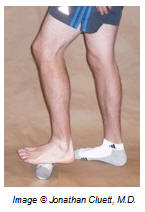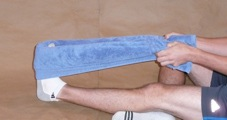The following exercises are designed to stretch the tightened plantar fascia along the foot arch

▲ Part 1: Slowly move the foot arch back and forth over a tin can or tennis ball
▲ Part 2: Ice the Foot Arch by rolling a frozen plastic water bottle or juice container under the foot for only ~5 minutes (overexposure to ice may inflict tissue damage).
▲ Pull back the toes until a stretch is felt in the fascia
The following study concluded that:"A program of non-weight-bearing stretching exercises specific to the plantar fascia is superior to the standard program of weight-bearing Achilles tendon-stretching exercises for the treatment of symptoms of proximal plantar fasciitis." BACKGROUND: Approximately 10% of patients with plantar fasciitis have development of persistent and often disabling symptoms. A poor response to treatment may be due, in part, to inappropriate and nonspecific stretching techniques. We hypothesized that patients with chronic plantar fasciitis who are managed with the structure-specific plantar fascia-stretching program for eight weeks have a better functional outcome than do patients managed with a standard Achilles tendon-stretching protocol. METHODS: One hundred and one patients who had chronic proximal plantar fasciitis for a duration of at least ten monthswere randomized into one of two treatment groups. The mean age was forty-six years. All patients received prefabricated soft insoles and a three-week course of celecoxib, and they also viewed an educational video on plantar fasciitis. The patients received instructions for either a plantar fascia tissue-stretching program (Group A) or an Achilles tendon-stretching program (Group B).All patients completed the pain subscale of the Foot Function Index and a subject-relevant outcome survey that incorporated generic and condition-specific outcome measures related to pain, function, and satisfaction with treatment outcome. The patients were reevaluated after eight weeks. RESULTS: Eighty-two patients returned for follow-up evaluation. With the exception of the duration of symptoms (p < 0.01), covariates for baseline measures revealed no significant differences between the groups. The pain subscale scores of the Foot Function Index showed significantly better results for the patients managed with the plantar fascia-stretching program with respect to item 1 (worst pain; p = 0.02) and item 2 (first steps in the morning; p = 0.006). Analysis of the response rates to the outcome measures also revealed significant differences with respect to pain, activity limitations, and patient satisfaction, with greater improvement seen in the group managed with the plantar fascia-stretching program. CONCLUSIONS: A program of non-weight-bearing stretching exercises specific to the plantar fascia is superior to the standard program of weight-bearing Achilles tendon-stretching exercises for the treatment of symptoms of proximal plantar fasciitis. These findings provide an alternative option to the present standard of care in the nonoperative treatment of patients with chronic, disabling plantar heel pain. BF Digiovanni, et al. "Plantar Fascia-Specific Stretching Exercise Improves Outcomes in Patients with Chronic Plantar Fasciitis. A Prospective Clinical Trial with Two-Year Follow-Up" J. Bone Joint Surg. Am., Aug 2006; 88: 1775 - 1781. Link In contrast, the "stair stretches"are standard weight-bearing stretching exercises designed to stretch the calf muscles and Achilles tendon. |

Using a towel to stretch the arch of the foot
Photo ©Jonathan Cluett, M.D.
▲ Above study recommends doing ten reps, holding stretch for 10 seconds three times a day. Doing the FIRST set BEFORE getting out of bed in the morning